Electrical Potential Energy
Electrical Potential Energy: Overview
This topic covers concepts, such as, Electrostatic Potential Energy of a Single Charge in Electric Field, Electrostatic Potential Energy, Self Electrostatic Potential Energy & Interaction Electrostatic Potential Energy etc.
Important Questions on Electrical Potential Energy
The electrostatic potential due to an electric dipole at an equatorial point is
The term ‘potential energy’ of charge ‘q’ at a distance ‘r’ in an external electric field can be defined as:.
Two point’s charges , initially at infinity, are brought one by one to points and , specified by position vectors and , relative to some origin. What is the potential energy of this charge configuration?
How does the electric potential due to a dipole vary on the dipole axis as a function of – distance of the field point from the mid–point of the dipole, at large distances?
Two point charges C and C are separated by a distance of 50 cm in air.
(i) Find the point on the line joining the charges, where the electric potential is zero.
(ii) Also find the electrostatic potential energy of the system.
A disk of radius with uniform positive charge density is placed on the plane with its center at the origin. The Coulomb potential along the -axis is
A particle of positive charge is placed initially at rest at a point on the -axis with and . In addition to the Coulomb force, the particle experiences a vertical force with . Let . Which of the following statement(s) is(are) correct?
Which of the following options are CORRECT about a non conducting, thin circular disk of radius and uniform surface charge density
(Assume electrostatic potential at infinity to be zero)
Two fixed conducting spherical shells, one of inner radius and outer radius and another of inner radius and outer radius are arranged concentrically as shown in figure. A point charge is brought from infinity to the centre of spherical shells by an external agent slowly. Then, which of the following options are CORRECT.
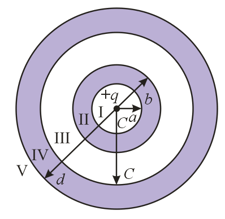
What is the radius (in ) of the imaginary concentric sphere that divides the electrostatic field of a metal sphere of a radius & a charge of in two regions of identical energy -
Consider a metallic sphere of radius concentric with another hollow metallic sphere of inner radius and outer radius as shown in the figure. The inner,sphere is given a charge and outer . The electrostatic potential energy of the system is
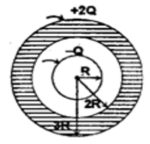
A spherical cavity of radius is made inside a solid uncharged conducting sphere of radius and a charge is placed inside the cavity at its centre. A point charge is placed outside the sphere at a distance '' from centre of the sphere, as shown. point is inside the sphere (at a distance from centre of the sphere) and point is inside the cavity ( at distance from centre of cavity). .
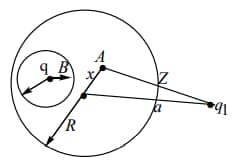
Choose the correct statement(s)
The figure shows the variation of electrostatic potential in volt with the distance of position of point along - axis from origin due to continuous volume charge distribution. In the region to , the graph is parabolic and rest portion of graph is straight line. Choose the correct option(s) permittivity of free space . The direction of along positive -axis is considered as positive.
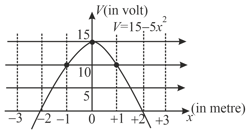
A thin ring made of insulating material has radius . Total charge on the ring is . The ring is now placed horizontally above a grounded solid metal sphere of radius , so that the centre of the ring and the top of the sphere coincide. The total charge induced on the sphere (in ) is ? Consider
Three charges and are placed at the vertices and respectively of an isosceles right angled triangle , angle being and . If and then energy required to dissociate the system of charges is , then the value of rounded off to closest integer is -
Three charges, and , are placed at equal distances, on a straight line. If the potential energy of the system of three charges is zero, then what is the ratio of ?
Three charges, and , are placed at equal distances, on a straight line. If the potential energy of the system of three charges is zero, then what is the ratio of ?
Two positive charges and are apart. The work done in bringing them closer to is
When a charge is carried from point to point , the amount of work done by the electric field is . What is the potential difference and which is at a higher potential?
A point charge q of mass m is suspended vertically by a string of length A point dipole of dipole moment is now brought towards q from infinity so that the charge moves away. The final equilibrium position of the system including the direction of the dipole, the angles and distances is shown in the figure below. If the work done in bringing the dipole to this position is where is the acceleration due to gravity, then the value of is ________. (Note that for three coplanar forces keeping a point mass in equilibrium, is the same for all forces, where is any one of the forces and is the angle between the other two forces)
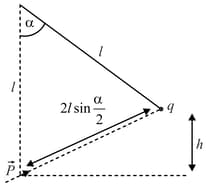
similar drops of mercury are maintained at each. All these spherical drops combine into a single big drop. The potential energy of the bigger drop ___________ is times that of a smaller drop.
